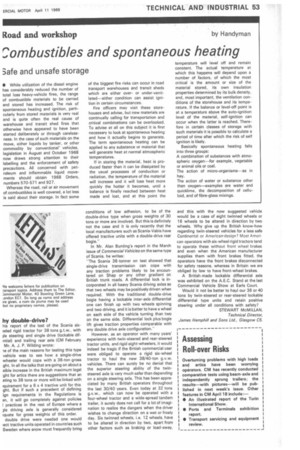hy double-drive?
Page 55

If you've noticed an error in this article please click here to report it so we can fix it.
his report of the test of the Scania six.ieled rigid tractor for 38 tons g.t.w.. with lie steering and single drive (lockable diffitial) and trailing rear axle (CM February Mr. A. J. P. Wilding wrote: le of the main reasons for testing this type vehicle was to see how a single-drive wheeler would cope with a 38-ton gross ght. In all the talks that are going on about a ,sible increase in the British maximum legal ght for artics there are suggestions that an ating to 38 tons or more will be linked with iquirement for a 6 x 4 tractive unit for this ght. But if such a precedent of defining ign requirements in the Regulations is an, it will go completely against policies I practices in the rest of Europe where a )le driving axle is generally considered iquate for gross weights of this order. double drive were needed one would iect tractive units operated in countries such Sweden where snow must frequently bring conditions of low adhesion, to be of the double-drive type when gross weights of 30 tons or more are involved. But this is definitely not the case and it is only recently that the local manufacturers such as Scania-Vabis have offered tractive units with a double-drive rear bogie."
In Mr. Alan Bunting's report in the March issue of Commercial Vehicles on the same type of Scania, he writes: "The Scania 38-tonner on test showed that single-drive transmission can cope with any traction problems likely to be encountered on Shap or any other gradient on British trunk roads. A differential lock is incorporated in all heavy Scania driving axles so that two wheels may be positively driven when required. With the traditional double-drive bogie having a lockable inter-axle differential one can finish up with two wheels spinning and two driving, and it is better to have a wheel on each side of the vehicle turning than two on the same side. Differential lock plus bogie lift gives traction properties comparable with any double drive axle configuration."
However, as an operator with many years' experience with twin-steered and rear-steered tractor units, and rigid eight-wheelers, it would indeed be tragic if the British commercial user were obliged to operate a rigid six-wheel tractor to haul the new 38/40-ton g,v.w. vehicles. There can surely be no denial that the superior steering ability of the twinsteered axle is very much safer than depending on a single steering axle. This has been appreciated by many British operators throughout the last 30/40 years. Even today at 32 tons g.v.w., which can now be operated with a four-wheel tractor and a wide-spread tandem trailer, it surely does not call for a lot of imagination to realize the dangers when the driver wishes to change direction on a wet or frosty day. Six twinned wheels, i.e. 12 wheels, have to be altered in direction by two, apart from other factors such as braking or load-sway,
and this with the now suggested vehicle would be a case of eight twinned wheels or 16 wheels to be altered in direction by two wheels. Why give up the British know-how regarding twin-steered vehicles for a less safe Continental or American, design Most Amer; can operators with six-wheel rigid tractors tend to operate these without front wheel brakes and even when the American manufacturer supplies them with front brakes fitted, the operators have the front brakes disconnected for safety reasons, whereas in Britain we are obliged by law to have front-wheel brakes.
A British-made lockable differential axle was exhibited on the A.E.C. Stand at the last Commercial Vehicle Show at Earls Court.
Would it not be better to haul our 38 or 40 tons by twin-steered or rear-steered lockable differential type units and retain positive steering under all conditions with safety?
STEWART McM ILLAN, Technical Director, James Hemphill and Sons Ltd., Glasgow C5.












































































































































